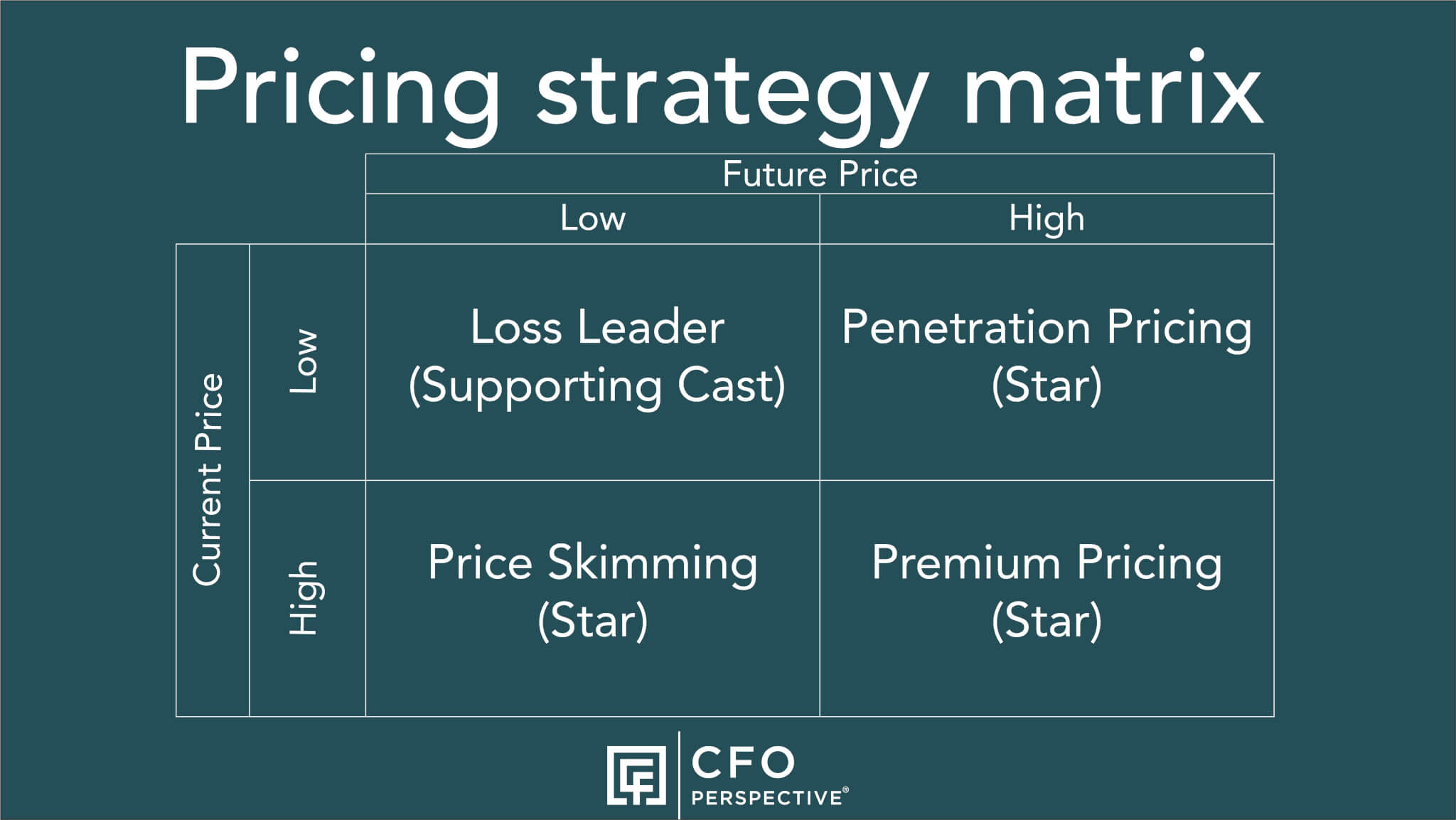These new product pricing strategies build lasting customer loyalty and value. Both current and future pricing are part of the definition of a good product pricing strategy.
You’ve put in the hard work to build your new product. It’s finally ready for sale. You have one critical decision left. What is your pricing strategy? You have many new product pricing strategies to choose from.
Your new product pricing strategy can attract customers, reap big profits, or communicate the value of your products and services. Pricing strategy sets the profit trajectory of your new product by defining current pricing and future pricing. Your new product pricing must also fit with your strategy for other products.
Pricing strategy definition
The definition of pricing strategy is your plan for current and future pricing to increase the long-term value of your company. Let me break that down a little.
“The definition of pricing strategy is your plan for current and future pricing to increase the long-term value of your company “
Current and future pricing: Your current price should be part of a plan that includes where you will set prices in the future. Your price will change with competitor prices and with your share of the market. Where you set your price today limits where you can set it tomorrow. You don’t want to set a price today that takes away your ability to set it where you want to position your product in the future. You also don’t want to set a price that communicates the wrong thing to your customers.
Long-term value of the company: Your new product is just one piece of the value of your company. This product may be the gem that produces the bulk of your profits. It may be priced to attract new customers. Both pricing strategies can increase the overall value of your company by building a following of loyal customers. All your products work together to build your brand and communicate how you serve your customers. They each provide value in different ways, but all work together to reveal the total value your company provides.
Pricing strategies for new products
Ask the following two questions before setting your price:
- What value do I want my company to provide to my customers?
- How does this product enhance that value?
This product may be the star of the show or just the supporting cast. The supporting cast develops the story of the star. Customer value is your story.
Pricing all products like stars causes customer confusion. In theater, the term “upstaging” refers to when supporting characters draw attention away from the star. More damaging, they detract from the story. Products should clarify the value you provide, not detract from it.
Your star products and supporting cast products should be priced differently:
• Supporting cast: These provide a benefit to your customers at a lower price. You provide this benefit for the opportunity to show the customer the greater value you provide with your stars. They supplement or replace traditional advertising. You can directly advertise your stars and you can sell products that explain your company’s value. Both communicate your story.
• Stars of the show: These often have the largest value and will command high prices over the long term. When your product it new, you may set the current price either low or high.
Here are four new product pricing strategies you can use to build customer loyalty. They are a combination of how to set pricing now and how to set prices in the future. The grid below summarizes the four new product pricing strategies.

How to use the four new product pricing strategies and examples
Loss leader
You price these low now and their price will stay low. They’re called “loss leaders” because the price may be below your costs for the product. The losses you take on this product will be more than offset by the increased sales of your stars. Your customers will have such a positive experience with your loss leader they are willing to pay more for your other products.
You use this new product pricing strategy to build trust with new customers and reduce their price sensitivity. You don’t have their trust in the beginning so they buy your product based on its low price. They feel they have little to lose if your product disappoints them. However, delighting them builds trust. They will look more at your value than your price once they trust you. And they will be willing to pay for that value.
Loss leader new product pricing strategy example: Grocery stores add store brand products as an alternative to name brands. The price starts very low and stays low. Popular products like milk or eggs are placed at the back of the store so shoppers walk past higher price items on the way to the loss leader. The loss leader draws people to the store and exposes them to higher profit items while they are there.
Penetration pricing
You set the price low now to quickly attract market share but you will raise it over time. The low price allows many customers to have a good experience with your product. The trust you build allows you to charge a higher price in the future.
If you are in the market early, your low initial price slows competitors from entering the market. Some will wait until prices have risen enough to cover their costs to develop a competing product.
You can also use penetration pricing to gain market share when you are new to an existing market. Your low price will cause customers to choose your product instead of one of the existing products.
Penetration pricing strategy example: You open a new hair salon and offer low prices at the beginning to attract customers. Another option is to list the future prices you would like to charge in the future as your current standard price. You then advertise discounts or free services during the first few months to attract customers. As your schedule fills up and you build a loyal clientele, raise your prices or stop the discounts.
Price skimming
A price skimming strategy is defined as setting a high price for your new product at the beginning and then reducing the price over time. Competitors see the high profits of your product and develop similar products. They will likely enter the market at a lower price than you to get market share. Lower your price as competition increases to reduce your loss of market share to the new entrants.
Skimming pricing strategy example: New computers or phones with the latest technology start at high prices. People eager for the latest technology (called “early adopters) will buy at these high prices. Over time, prices will decrease to convince other customers to trade up to the latest technology. You will also drop the price as more competitors offer the new technology.
Premium pricing
Have you ever gone to a concert where the crowd roars from when the band takes the stage until the last encore? That’s like premium pricing. You’ve built a loyal fan base. Your competence, confidence, and credibility command a high price from the beginning. Continued support from new and old fans means you never need to drop your price.
You usually need to have a supporting cast product or an existing star product to get premium pricing. The supporting cast is like the opening act or “warm-up band” at a concert that gets the crowd ready for the big act.
Having an existing star shows your ability to provide huge amounts of value. Your customers’ trust in you from that star will carry over to your new star.
Premium pricing strategy example: Luxury car makers offer high-quality products at premium prices. They also use advertising to create an aura of prestige around their product. The premium pricing attracts customers who want high quality and the prestige these vehicles give to the owner. These customers are often very loyal to these premium brands.
Avoiding new product pricing strategy mistakes

Watch out for these pricing mistakes when implementing the four major types of new product pricing strategies.
Giving away or underpricing your product
You can take the loss leader strategy too far. The faulty logic says, “If selling my new product at a low price is good for marketing, giving it away is even better.”
Let’s take that faulty logic even further. Why stop at free? How much would you pay people to take your product? Wouldn’t they get suspicious if you were paying them to take your product?
People take cues from prices. Pricing should approximate the perceived value. Customers get suspicious when there’s a large gap between price and value. That suspicion tanks trust and sales.
I first learned this when I worked at a non-profit agency in Seattle. They were willing to provide free educational seminars at companies to improve the health of the company’s employees. They found that if they offered it for free, companies weren’t interested. If they charged for the seminar, companies looked more seriously at the value it provided for their employees. Price communicates value.
Having the lowest price may be producing little value
Every company had a desire to grow. Building loyal customers takes time. It’s easy to juice growth through lower prices. It can be a viable strategy, but it’s often done wrong.
Being the lowest price in the market can cause low profitability and weak franchise value. You’re attracting customers who have little loyalty. They’re easily poached away from you by whoever is offering the lowest price. Growth may seem like progress but it’s a total waste if it doesn’t lead to loyal customers.
Cannibalization
A new product can “cannibalize” sales of existing products. The definition of sales cannibalization is when one product decreases sales of another product. For example, a new product may be better than an existing product, causing people to stop buying the existing product. This may be part of your new product strategy or you may be surprised that your new product is eating into sales your existing product.
Sales cannibalization is a problem when the existing product losing sales has a higher profit than the new product. This may occur when you offer the new product at a low price using a loss leader or penetration pricing strategy. Total company profits will suffer.
The price skimming strategy example of phones I used above is an extreme case of sales cannibalization. People wait in lines for the new iPhone. Everyone buys the new models and sales of existing models cease. The cannibalization is so strong that sales slow before the release of the new model because people wait to upgrade so they can get the newest model.
Price cannibalization is a massive hit to profits that owners often overlook. The definition of price cannibalization is the difference between a higher and lower price of a product multiplied by the number of units you would sell at the higher price.
For example, let’s say you usually sell your widgets at $100 but you lower the price to $90 to drive growth. If you normally sell 1,000 widgets, your profit dropped $10,000 ($100-$90=$10 X 1,000). Do you know how many more widgets you need to sell at the lower price to recoup this lost profit?
Profit projections for new products must include sales cannibalization and price cannibalization. I explain how to model price cannibalization in this article.
The toughest sale

The toughest sale isn’t to your customers; it’s to your sales staff. When I set pricing at companies, these staff bore the brunt of the customers who weren’t happy with the price change.
Sales staff were painfully aware of the deals they lost. Pricing low to keep those customers would mean higher sales but lower profits. We weren’t the lowest price, but we were very competitive when looking at the full breadth of the market.
You will always lose some sales. Customers that chase the lowest price offer little value to your company. Chasing those customers will cause you to lose profits from customers that truly value you and your product. Never sell yourself short to those who don’t value you.
Successful pricing strategies for new products – and old

Your new product pricing strategy must consider both your new product and your existing products. All your products work together to define the value you provide to your customers.
You must understand the role of your new product compared to other products. Then you can develop a plan for how pricing will change over time.
New products impact the sales and profits of existing products. Model the profits of the new product and the change in profits on existing products.
Your product stars and supporting cast products tell the story of your company. What role will your new products play in your company’s story?
For more info, check out these topics pages:
